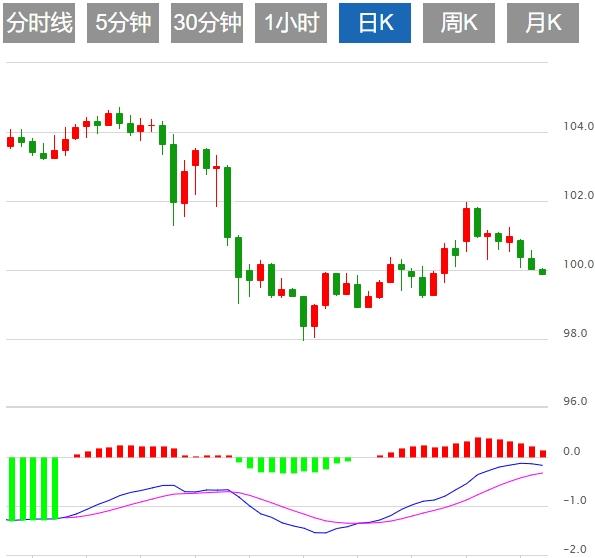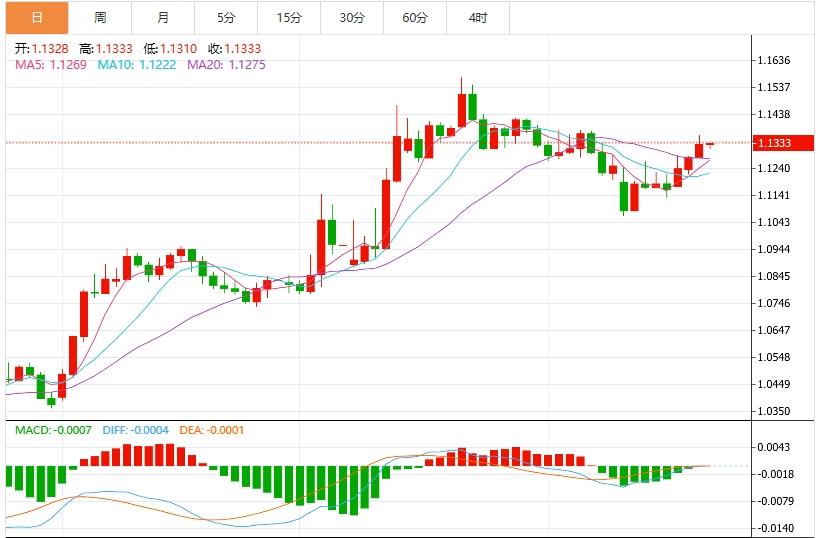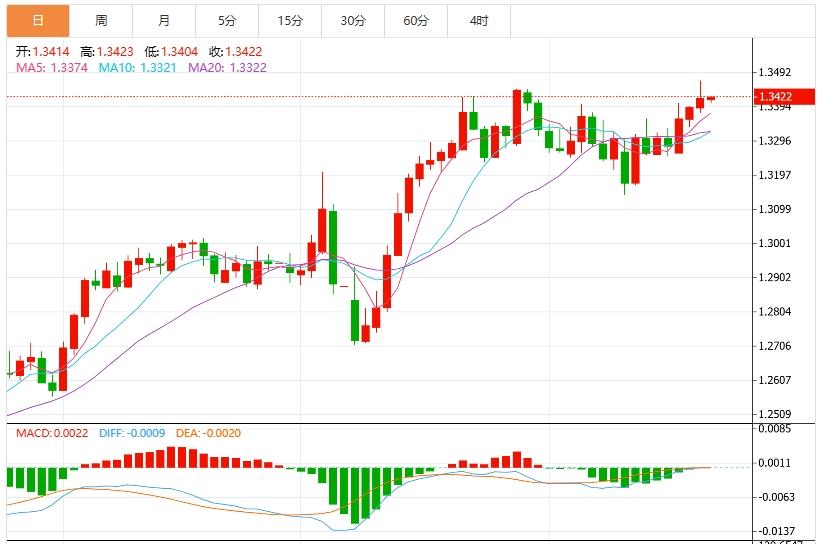Wonderful Introduction:
Don't learn to be sad in the years of youth, what www.avaforexcn.comes and goes cannot withstand the passing time. What I promise you may not be the end of the world. Do you remember that the ice blue that has not been asleep in the night is like the romance swallowed by purple jasmine, but the road is far away and people have not returned, where can the love be lost?
Hello everyone, today Avatrade Aihua Foreign Exchange will bring you "[Avatradescn]: The US dollar index fluctuates downward, and the European and American PMI data is www.avaforexcn.coming heavily." Hope it will be helpful to you! The original content is as follows:
On Thursday, the US dollar index fell slightly, and the US dollar index performed weakly recently, falling 0.6% on Wednesday, losing the 100 integer mark, and the intraday low hit a new low of 99.33 in the past two weeks. Current market sentiment shows obvious characteristics of caution. On the one hand, geopolitical risks continue to ferment, especially the uncertainty of the situation in the Middle East has exacerbated the market's risk aversion; on the other hand, the domestic political deadlock in the United States and the uncertainty of the tax reform bill have further increased market volatility. This trading day will be released on PMI data in European and American countries in May, changes in the number of initial unemployment claims in the United States, and the total annualized number of existing home sales in April. Investors need to pay attention to it. In addition, we will continue to pay attention to the international trade situation, geopolitical situation and news related to the G7 meeting, and pay attention to the speeches of Federal Reserve officials.
Analysis of major currencies
United States dollar: As of press time, the US dollar index hovered around 99.48, down 0.11% during the day. Since the beginning of this week, the dollar has paid the price for the volatility of Trump's administration's policies, which is currently facing difficulties in many aspects. Hawkish rhetoric by Fed officials has significantly lowered market expectations for a recent rate cut, which provides support from the dollar to some extent. However, the ongoing political uncertainty and geopolitical risks put pressure on the US dollar, forming a delicate balance. It can be observed from the daily chart of the US dollar index that the price is in a key technical position. After experiencing a sharp decline in the previous period, DXY has now gained some support near the 99.20 area. Previously, the index hit a low of 97.9229 and then launched a rebound, but recently fell back under pressure. In terms of MACD indicators, the DIFF line is-0.2228, DEA line is -0.3051, MACD value is 0.1644, the bar chart is red, but the cylinder height is shrinking, which may indicate that the kinetic energy is weakening.



1. The weak 20-year U.S. bonds and foreign exchange fell, and the value of US bonds and foreign exchange fell. After the results of weak demand for US 20-year U.S. Treasury bonds and foreign exchange fell one after another. Deutsche Bank analyst George Saravelos sees the market's reaction as a clear signal of "foreign buyers collectively avoiding U.S. bond assets." He noted that foreign investors "are no longer willing to fund the U.S. government at current prices." The rise in financing costs is putting pressure on the stock market. Unless there is a major adjustment in the fiscal settlement bill proposed by the Republican Party, the value of U.S. bonds will have to "sharply decline" to re-attract foreign investors. Affected by this, the S&P 500 index's intraday decline expanded to 1.5%, and 10-year U.S. Treasury yieldsThe rate once rose to 4.607%, the highest level since February 13, with the US dollar index falling 0.5%. 2. Source: The EU prepares a trade proposal for the United States to promote negotiations
According to foreign media reports, the EU is expected to share a revised trade proposal with the United States. This move is intended to inject momentum into negotiations with the Trump administration. The outside world is still skeptical about whether a transatlantic agreement can be reached. According to people familiar with the matter, the new document contains proposals that take into account U.S. interests, including international labor rights, environmental standards, economic security, and gradually reducing tariffs on non-sensitive agricultural and industrial products from both sides to zero. The document, submitted to officials in Washington earlier this week, also outlines mutual investments and strategic procurement in the fields of energy, artificial intelligence and digital connectivity, people familiar with the matter said. The EU's goal is to cooperate with the United States and seek a balanced and mutually beneficial agreement, people familiar with the matter said. One of the people familiar with the matter said the two sides are still studying each other and the European www.avaforexcn.commission may need to be authorized by member states to begin formal negotiations.
3. The Speaker of the U.S. House of Representatives said it had reached an agreement on the $40,000 state and local tax deduction cap
According to foreign media reports, U.S. House of Representatives Speaker Johnson said that Republicans have reached an agreement to raise state and local tax (SALT) relief to $40,000, which means solving one of the last few issues hindering Trump's economic bill. "This is the agreement we reached, and I think the SALT caucus, as they claim, isn't everything they want, but I think they know it's a huge improvement for their constituents, which gives them a lot to go home and talk about," Johnson said Wednesday in an answer to a question about increasing the deduction cap from $10,000 to $40,000 over a 10-year period. According to a person familiar with the matter, the $40,000 SALT limit will be phased out for people who earn more than $500,000 a year.
4. ECB warns that US asset concerns trigger a ripple effect
The ECB warns that investors' concerns about U.S. asset risks have increased after Trump's tariffs, which may further impact the global financial system. In its Financial Stability Assessment, the ECB stated that after the April trade statement, the "unconventional shift" of investors from traditional havens such as the US dollar and U.S. bonds may herald a "fundamental institutional change", which increases the risk of "widespread changes in global capital flows", which "may have far-reaching impacts on the global financial system." The bank said the unpredictability of U.S. policy seems to lead investors to higher risk premiums for U.S. assets, and may also shake people's confidence in the US dollar as a global reserve currency and U.S. sovereign bonds as a safe-haven asset. Decision makersIt pointed out that asset valuations are still at high levels, especially after Trump's policy pullback triggered a market rebound. In addition, concentrated investment in US technology stocks means that the market is still susceptible to sudden volatility. The ECB said: "Investors may underestimate the possibility and impact of the adverse scenario, especially because the surge in uncertainty makes tail risks more prone to manifest."
5. Former Bank of Japan member: The window for hikes on the Bank of Japan is narrowing
Former member of the Bank of Japan's www.avaforexcn.committee, Yuri Shirai said that if the bank hopes to raise further rates, it may need to take action within this year, otherwise the window period will be closed. Japan's weak domestic demand has made interest rate hikes insufficient reasons. If inflation falls below the central bank's 2% target, interest rate hikes will be more difficult to advance. She said: "The Bank of Japan may want to promote policy normalization in time as much as possible, even if it can only slightly correct the excessive depreciation of the yen. However, Japan's economy is too weak and fragile domestic demand is incompatible with the path of interest rate hikes." Although Japan's wage growth shows positive signals, continuous inflation suppresses household spending. The latest government data shows that private consumption remained unchanged from January to March. The central bank expects consumption inflation to slow below 2% in the next fiscal year and in the following year starting from April 2026, which Shirai believes will www.avaforexcn.complicate further interest rate hike decisions. Growth headwinds are also intensifying. Japan faces the risk of a technical recession after its economic contraction in the first quarter. Exports to the United States fell for the first time in four months in April, highlighting the impact of high tariffs.
Institutional View
1. Dutch International: As soon as the UK inflation data came out, the focus turned to central bank's August interest rate decision
Dutch International Group economist James Smith said in a report that the UK's April inflation data www.avaforexcn.completely wiped out the Bank of England's hope of interest rate cuts in June, but the survey shows that pricing power is weakening and interest rate cuts are still possible in August. April CPI rose 3.5% year-on-year, up from 2.6% in March. Crucially, service inflation — part of the inflation basket that the Bank of England cares most — soared from 4.7% to 5.4%. "This is a much bigger rebound than we or the central bank expects," Smith said. However, part of the rise is based on road taxes and Easter times, which the Bank of England may ignore. He said the service sector inflation rate should fall back to 4.5% in the summer, which is enough to cut interest rates in August.
2. Deutsche Bank: Investors are worried about fiscal balance in countries outside the United States
Deutsche Bank analyst Jim Reid wrote that the United States is not the only country that has caused fiscal concerns. He said demand for 20-year bond auctions in Japan yesterday fell to its lowest level in 10 years. Reid pointed out that the current debt-to-GDP ratio of the United States and the United Kingdom is 100%, while Japan is 250%, while the proportion of these countries was 41%, 42% and 113% respectively when Japan issued 30-year sovereign bonds in 1999. "We have never experienced a bond market with a maturity of more than 30 years in the context of such high global debt levels. This is an unknown area," Reid said.The bond supply will increase in the next few years, "so the long-term market urgently needs inflation to be controlled."
3. Morgan Stanley analyst Bruna Skarica said in a report that despite the higher-than-expected inflation in April, the Bank of England may stick to its loose policy route. She said the 3.5% annual CPI increase was not a particularly big hit because it was driven by one-time administrative and tourism spending. However, even if inflation may be more moderate in May and the June job market report will show a significant decline in wage growth, it seems unlikely that the Bank of England will cut interest rates in June. "Before August, a lot of things could happen," Skarica said, including a drop in inflation expectations. She said: "We still expect interest rates to be lowered and will be continuously lowered to 3.25% by the end of the year."
The above content is all about "[Ava Aihua Foreign Exchange]: The US dollar index fluctuates and goes down, and European and American PMI data is www.avaforexcn.coming." It is carefully www.avaforexcn.compiled and edited by the Avatrade Foreign Exchange editor. I hope it will be helpful to your trading! Thanks for the support!
Every successful person has a beginning. Only by having the courage to start can you find the way to success. Read the next article now!















